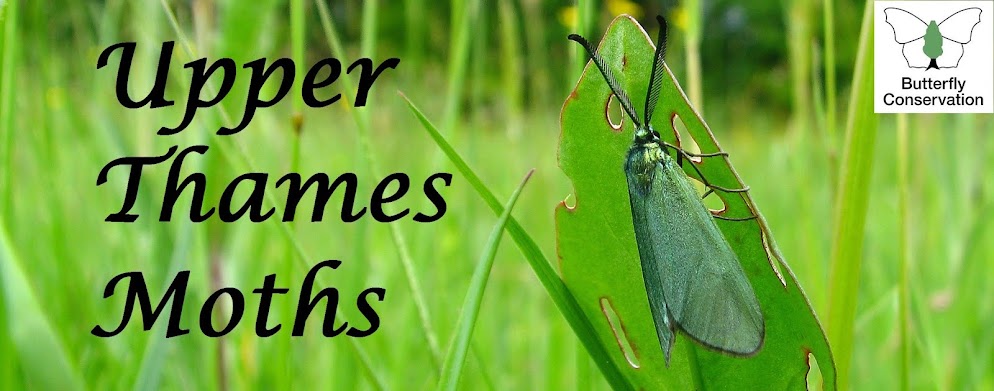I made a foray out into Berkshire last week, heading to Greenham Common to look for some of the winter-active miners. My main target was Phyllonorycter scopariella on Broom, and after much wandering around trying to locate the foodplant and the mines, I eventually found a single mine as the light was fading (ID kindly confirmed by Rob Edmunds). I found a couple of others that looked similar, but couldn't find the frass inside to be sure of the ID. I think this might be the fourth Berkshire record, following a few in Brian Baker's book?
 |
| Phyllonorycter scopariella mine on Broom |
 |
Phyllonorycter scopariella mine on Broom
(opened up to show the frass left by the larva) |
By chance, I also spotted another mine of Phyllonorycter ulicicolella on Gorse while checking some Broom, and found a total of 8 mines all on the one bush. Trifurcula immundella was also quite abundant on Broom across the site too, with some bushes having 50+ mines on. This species forms quite subtle black mines that can be separated from the similar looking mines of Leucoptera spartifoliella by the distinctive egg-shell, which remains on the outside of the mine.
 |
| Phyllonorycter ulicicolella mine |
I found both of these species up at Bagley Woods a few weeks ago with Marc Botham as well, alongside 40 or so other species of miner, including Ectoedemia rubivora (on Bramble), Phyllonorycter comparella (Grey Poplar) and Coleophora albicosta (gorse) and laricella (Larch).
 |
| Trifurcula immundella mine - the distinctive egg shell is shown in the inset. |





Interesting post Will; you didn't happen to notice workings of the dipterous miner/galler Hexomyza sarothamni (picture here https://bladmineerders.nl/parasites/animalia/arthropoda/insecta/diptera/brachycera/agromyzidae/agromyzinae/hexomyza/hexomyza-sarothamni/). I'm looking for it to rear its parasitoids.
ReplyDeleteThanks Charles! I don't think I did see it, obviously I was mainly looking for moths, but it looks quite distinctive in those pictures. That said, I didn't cover the whole common, or even all the Broom, so it could be lurking somewhere there. I'll keep an eye out in future, as there are a couple of other spots with Broom that I'm still planning to visit (and I might go back to Greenham), and I can let you know if I come across it.
DeleteMany thanks Will; it's rare but there's an old Berks record so hopefully it might be about. Incidentally, while the parasitoids of most Phyllonorycter are very well recorded those attacking scopariella and ulicicolella are very poorly known so if you rear any do keep an eye out for tiny wasps.
DeleteWhat a great selection of mines! Locating wild broom is the difficulty in my area (gorse isn't widespread either). You could perhaps make a name for yourself by re-finding Broom-tip in Berkshire next April as Martin's lists for the BMG and Baker's book both suggest that the last record was at Wildmoor Heath in 1984. In VC24 we have only one decent site for it and that's up on the greensand on the border with Bedfordshire.
ReplyDeleteThanks Dave! I've struggled to locate any broom as well (it was just a guess that there'd be some at Greenham), but when I have found it I've never yet not found Trifurucla immundella, so it's worth looking out for. Scopariella has been one I've wanted to find for a while as well, so it was very satisfying. The patch of Broom where I found it was reasonably large (at least 25 plants), and I didn't cover the whole common, so there may well be sufficient habitat for Broom-Tip at Greenham, I might have to give it a go. I failed to find Streak larvae back home in Somerset this year, so I feel like there's unfinished business with that group too.
DeleteThere is plenty of broom on the west side of Cumnor Hurst (VC Berkshire) and there ought to be a fair few stands around the Frilford area - might be worth looking there.
Delete